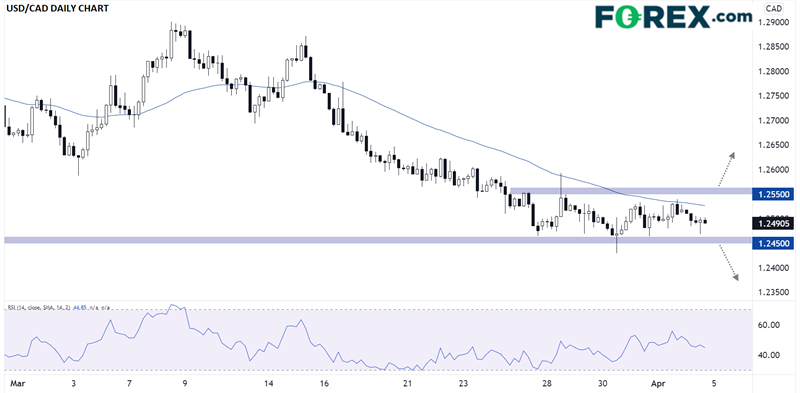Between the big moves that we’ve seen in the euro, yen, and Australian dollar in recent weeks, many traders have understandably shifted their attention away from USD/CAD. The North American pair has spent more than a week consolidating within 50 pips of the 1.2500 level as traders await the emergence of a new trend.
Both of the underlying countries, the US and Canada, are seeing relatively robust economic growth, though persistent price pressures are prompting fiscal and monetary policymakers to tighten policy aggressively. Indeed, traders are pricing in a roughly 75% probability that the FOMC will raise interest rates by 50bps at its next meeting in early May, with about 185bps of rate hikes priced in for the next six months…compared to a roughly 66% chance that the BOC will raise interest rates by 50bps at its next meeting and 170bps of tightening priced in over the next six months!
Notably, Friday’s mostly as-expected NFP report was not significant enough to shake USD/CAD from its torpor, though this Friday’s Canadian jobs report will be worth watching. Readers may recall that last month’s Canadian employment report showed a gain of nearly 340K new jobs, of which more than 120K were full-time positions; given the relative size of the two countries’ populations, this reading would have been equivalent to a headline NFP print of more than 3M jobs! Economists are expecting a big moderation from last month’s stellar reading, with roughly 80K net new jobs and roughly 40K of those being full-time.
Looking at the chart, the first area to watch will be the current near-term range between 1.2450 and 1.2550. A bullish breakout, if seen, would project a measured-move objective near 1.2650, but a bearish breakdown may be more likely given the recent downtrend and potentially strong Canadian economic data on the docket. In that case, a quick move down to 1.2350 or even October’s lows around 1.2300 could be next:
Source: TradingView, StoneX
After settling onto the backburner through last week, USD/CAD may be poised for a breakout and higher volatility this week.


